|
|
| How
to cook Fish Chinese Style |
How Chinese
Chef's Cook Fish in China |
|
The vast majority of Chinese fish are
full of small bones (Like real 'Kippers') and Chinese
people like to eat their fish whilst enjoying the bones
nightmare. Westerners do not!
Unlike other countries China does not have many specific
fish dishes, unlike in the west - you simply go and
choose which fish you want to eat, and tell them how
you want it cooked Therefore we will begin by explaining
how Chinese chef's cook fish - which is either mainly
steamed or sautéed (exceptions).
Basic Chinese Fish Cooking Process
Chef's will spend a lifetime mastering how to steam
a fish according to its weight. It is served the second
it is just done - and they time it to the second! Here
are the two common methods:
Steamed fish
Gut and descale the fish (Usually done by the vendor)
and wash it well to also ensure all the body sac is
removed. Chefs may keep the fish liver and other offal
but we will discard it for ease. Leave on the head,
tail, and all the fins.
Lay out on a metal platter and rub with a little salt,
sitting it on a bed of diced fresh ginger and thinly
chopped garlic. 1 ounce of each should be sufficient
for a fish up to a foot long.
Set a bed of standard herbs on a light metal platter.
Add:
1 oz finely diced fresh ginger
1 oz thinly chopped garlic
1 oz finely diced spring onion leaves.
2 Tbls quality soy sauce (Kai Ping City made is
best)
Set the fish on the platter as meanwhile you bring a
large wok (15 inches) to a strong simmer with an inch
of water in the bottom. Put the lid on and reduce temperature
until you have a consistent medium simmer. Once settled
add the platter of fish and cover.
Cook on one side for 5 minutes before turning and cooking
the other side for the same time. Reduce time to 4 minutes
for smaller fish, and increase for larger fish. Remember,
if this is your first time you can always slide a knife
inside the thickest point and check for blood, whatever.
When turning the fish place it down on the metal and
move remaining ingredients to the side. Some will be
covering the fish and you can leave these. If you think
the fish will break then cook only on the one side -
but know that this means it is probably already quite
well cooked.
Serve to table on the cooking platter, removing any
excess oils of which there should hardly be any - they
should all still be inside the fish. Finish by heaping
the ingredients on top of the fish and make an appealing
arrangement.
You can add fresh cress as a garnish, or use the Chinese
equivalent which looks like shoots of grass and has
a slight lemon taste. Serve to table.
Sautéed Fish - This is usually the
home-cooked version.
To a wok add a couple of teaspoons of quality oil and
some cloves of garlic. These can be whole or thinly
chopped, or a mixture. Add 1 ounce of thinly diced fresh
ginger - like blades of grass. Turn to a high heat and
stir for 1 minute ensuring not to brown the garlic.
Place the fish in the pan and cook for 2 minutes each
side to they are slightly brown. Add a couple of slugs
of quality soy sauce (2 tablespoons) and stir carefully
around so as not to disturb the fish. Reduce the heat
to a gentle simmer. Cover and leave for a further 5
minutes - less for smaller fish, more for larger fish.
Transfer the fish once cooked to a serving dish and
allow to rest while you finish the dressing. Add to
the wok 1 ounce of similarly sized chopped spring onion
leaves and turn up the heat once more, stirring quickly
for 1 minute.
Using a spatula spread the herbs along the fish and
to the side in a nice presentation. Pour over the residue
sauce, or enough to cover the base of the serving dish.
Leave any burnt or oily residue in the wok, although
there should not be any if cooked perfectly.
Chinese serve to table immediately with fish being the
most revered dish of the meal.
Presentation
Chinese Chef's normally lay the fish on the serving
platter on its right side, so the left flank is exposed.
I do not know why, it is simply what they always do
as I have observed. It is then dressed and served to
table.
There is one exception, which is reserved for large
or unusual fish - and also is a great way for a novice
chef to check whether it is in fact cooked properly
all the way through.
The fish is served upright, but cut through on the left
side and so much so all the major bones to the immediate
left of the backbone are severed (Needs a very sharp
knife!).
However, most Chinese cooks cheat and actually use the
left main bones as a guide to cut too. This would be
the more common presentation.
Once divided the fish is then pressed into the wok on
a good heat so that it separates into a 'Y' shape (upside
down of course) and once sealed in shape (Seconds),
you should Steam or Sautée for less time than above,
and to avoid burning the flesh steaming is much preferred.
Once cooked it is served to table. This allows
for a better presentation and added flexibility with
accompanying herbs and sauces.
If you ever eat a fish presented this way, then know
that the right-hand side is always the preferred side,
at least in China. To be certain you should take meat
from the centre and draw it off the bone. If you see
the bones are joined to the central vertebrae, then
this is the good side. If they are not, then you need
the other side of the fish. Simple.
If both sides are joined to the vertebrae, then in the
northern hemisphere always choose meat from the right
side
Note - Significantly related:
In which direction does water flush in your part of
the world? Northern hemisphere = anticlockwise = the
fish has more developed muscles on its right side (Better
meat). You may consider this to be irrelevant, but Chinese
Chef's consider it to be an important factor.
Chinese Fish
In China they cook any fish they can get hold of, and
nearly all will be freshwater river fish or pond-farmed
fish. The vast majority are blue carp that can grow
to many feet in length, but catfish and many other varieties
including eels also regularly grace Chinese tables.
Chinese people only kill the fish (By bopping it on
the head) moments before gutting, de-scaling, and cooking.
Know that sometimes they do not bother to kill the fish
first! Fresh and healthily alive is priceless in Chinese
cuisine. Please look to the right hand menu where you
will see pictures of many of these fish.
Cooking Chinese Fish in the West
In the west you will have a far smaller variety of freshwater
fish, in fact you will have a far smaller variety of
fish full stop. So what can you use instead?
We suggest you forget Carp and look for Bream and Trout.
These fish lend themselves ideally to Chinese style
cooking, as does Pike. We would say the best is Red
Mullet, which is also very common on Chinese tables
and is usually sautéed.
We now enter the realms of sea fish, so know your fish
and interpolate. Mackerel are ideal and very good for
you. Other fish may see you referring to a cookery book
to get the ideal weight to time ratio. Do not use fillets
as Chinese cooking is designed to cook the whole fish,
although you could remove the head and tail if you are
squeamish.
Other Culinary Techniques of
Chinese Kitchens
Fish Casserole
This is normally a fish cut into chunks 2 or 3 inches
square and battered with the simplest flour/water mixture
of (often) quite thin proportions. Please check our
Fish Batter
page for full instructions.
The dish is served in a large ceramic bowl about 1 foot
across by 5 inches high. This is often heatproof and
may be served to a central burner in the middle of the
table.
Other ingredients vary depending upon cooking style
and ethnicity, but they nearly always have a relatively
thick soup gravy of natural design, and either or both
garlic and ginger, the latter being more important.
This 'soup' is started in a large wok and builds up
from the basic herbs and spices (a little oil, ginger
slices, chopped garlic). You would be safe to add a
couple of scoops of chicken bouillon, dash of soy sauce,
fish sauce, diced celery and spring onions. Use water
carefully to thin, but not too much - better to add
a little and often.
Seal the fish in a different wok until the outside is
slightly brown on all sides and crispy, then add all
to the main wok and simmer for 20 minutes - longer for
a larger fish.
Put the dish together in the large ceramic bowl and
present to table, setting centrally on the burner (Low
heat).
Fish Hotpot
This dish will normally be associated with a a large
stainless steel cauldron set onto a centre table burner.
It would be quite normal for this to be a delicate dish
(Cantonese), or more probably a divided dish one side
fiery and the other delicate (Mongolian),
or a chilli nightmare (Sichuan Style). Let me explain:
There are two elements to this specific dish; the fish,
and the hotpot - which in China means a very large bowl
into which all the ingredients and spices are prepared
before hand, then reheated for a serving.
The second is the fish, which is served whole after
being steamed to 'almost cooked' separately, and then
added to the serving dish before it is topped up with
the fluids, herbs and spices + whatever.
The Mongolian dish is different and you cook small pieces
of fish in the side of your choice at the table - a
bit like a fondue. Here wafers of fish are joined by
squid pieces, whitebait, and other varieties.
Smoked Fish
Smoked fish is normally bought ready smoked and available
at every wet market. Large eels are very common, but
may be a bones nightmare? Better check a small bit first.
They are normally trapezoidal in shape with a meaty
central ring of creamy colouration.
Depending upon region and availability, whole fish or
fish sections may also be available, and are definitely
worth trying.
Smoked fish is regarded as being already cooked, so
either serve as it is, or wok fry in a hint of oil and
soy sauce for 1 minute before serving. Dress with Chinese
cress and thin strips of ginger, and serve with a dribble
of the soy sauce used for cooking.
Salt Dried Fish
Many Chinese people do this at home - and my wife has
done it several times! Basically all you do is clean
and gut the fish, then cut it in two leaving just the
upper dorsal area to keep the two halves together.
The next step is to cover them with salt and work it
well in to the whole fish. My wife then sticks them
up on a clothes line and leaves them to dry naturally
for about one month.
Note: Because of the high amount of salt nothing touches
the fish.
Chinese would consider these fish to be already cooked,
so sometimes simply offer them as a tasty snack with
dips on the side (Chilli, sesame seed, whatever). However,
they are normally used in a stir fry where they are
cooked in a little oil, soy sauce, garlic and ginger.
Cooking takes one minute before you present the fish
halves or slices to table, complete with the sauce and
trimmings of your choice.
I think you can use any fish, but narrow ones are best.
My mother in law does this with 'long thin fish' = they
are silver in colour and over 2 feet long by up to four
inches high, and half an inch thick. Her husband farms
them in the local pond. They have a long and pointed
nose with many small and nasty looking teeth.
Imperial Platter
I have used this general term to imply that this style
of meal and presentation is very special, and perhaps
only to be found at weddings and top restaurants (Top
fish restaurants at least). The pork version is quite
common and based upon suckling pig, but here we look
at the fish version - which is delicious!
For this you will need something like a large wedding
cake base about 2 feet diameter. It is better if it
has a lip. Cover this with dry crushed ice, and layer
on top crispy Chinese vermicelli (Very thin rice noodles
that have been previously cooked, just. These are added
to the hottest wok with a generous amount of oil and
fried for moments on a very high heat, so they are white
and crispy.
Add the vermicelli noodles immediately so they stop
cooking, but drain well first. Then layer three types
of raw fish. The normal ones are two boneless white
meat fish, and Chinese salmon.
Cut the salmon into chunks 3 inches wide by 2 inches
deep by 1/4 inch thick and layer in the centre. Allow
at least one portion for each person, and two is better.
To one side add wafer thin cuts of a raw fish. Chinese
would use a very large carp from which all the bones
have been removed. Make into squares about 1 inch across
or slightly larger. Remember to size all cuts exactly
the same.
Very often Chinese will replicate the second thin slices
on the other side of the salmon, but I would use a third
fish as served in better restaurants. Therefore I would
use a sea fish or bream, again uncooked and sliced to
the exact same proportions. Something like 'Wong Fa
Yue' would make an ideal contrast, as this is an oily
sea-fish like sardines, but far larger in size.
To adjust this for fish available in UK, then the salmon
should be fine, but pay for best fish as this is raw.
To either side I would set one to be haddock flakes,
and the other side to be mackerel cut to similar proportions.
Chinese would finish the dish here with colourful prawn
crackers scattered around and the bottom with a selection
of herbs and diced fruits. Served alongside would be
various dips of your choice - chilli sauce, sesame seed
sauce, and soy sauce.
You would be better served to devote the bottom sector
of this dish to appropriate sauces and dips. I would
keep the soy, but add an inch of wasabi to the centre
of one condiment dish; or add a little 'mustard and
cress' and many thin sliced chilli rings (they loose
pungency when soaked for 10 minutes). I would put Tartare
sauce in another, and spicy salsa in yet another. Thousand
Island dressing is another winner, as is a mildish green
chutney. Decorate with parsley sprigs, a little fresh
coriander, and offer a finely chopped side salad which
includes tomatoes. Crisp bread wafers (slow-toasted,
not discoloured) and a curve of cooked Plaice roe (Or
is it Sole?) would be ideal embellishments.
Raw Fish
Most of what you need to know about Chinese raw fish
is covered in the paragraphs above. I do not call it
'sushi' because it is simply sliced raw fish without
all the extra work - well, except they will try and
remove all the bones (no promises)..
Serving is almost identical to above also, but simply
layers of raw fish on the vermicelli noodles. Accompanying
dips would normally be a soy sauce, and either a plum
or oyster sauce - tipped straight out of the jar into
a condiment dish.
Normally in China, this dish is served in Bamboo fish
restaurants, where you all gather at tables around a
pool and catch your own fish (Carp). They will net one
for you of your preferred size of course, but this is
a great way to pass a few hours in company, and 'very
manly'.
You can be sure that biological hazards are taken very
seriously by participants, as these are basically 'any
old fish' and not ones specified for being eaten raw.
Therefore all Chinese follow the standard practice:
= 1 piece of raw fish followed immediately by one nip
of rice wine. I am told the rice wine will kill any
microbes and bacteria that may be harmful.
On the other hand, if you are of the persuasion that
you would have to be very drunk to eat unknown raw fish
- then this is your opportunity!
I have enjoyed this dish many times in China and it
is a great social occasion. I have also lived to tell
the tale; if not always remembering the day before and
the night after!
Related Pages:
Now that you know the basic ways Chinese chef's use
to cook fish, we advise you to read our related page
Regional
Cuisine
|
|
 |
|
This information is as supplied by ourselves, and ably
supported by our friends and various internet portals. |
|
| Search
this Website |
|
|
| Descriptions |
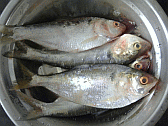
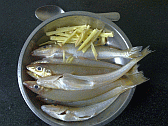
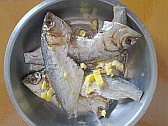
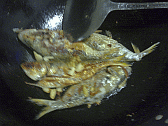
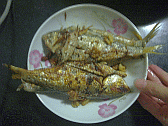
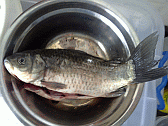
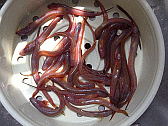
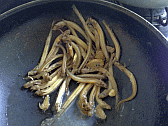
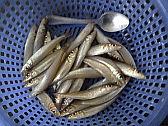


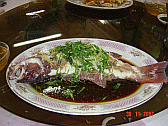
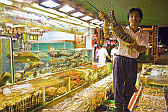
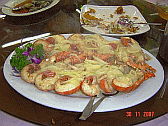
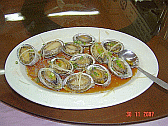
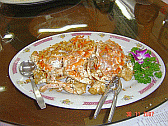
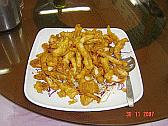
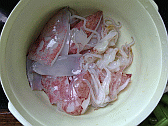
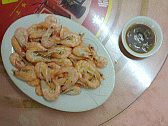
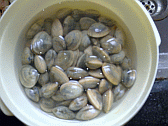
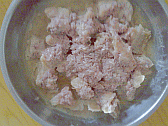
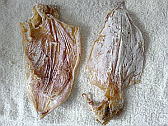
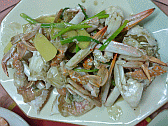
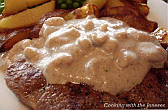
|
| Chinese Recipes |
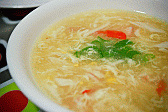
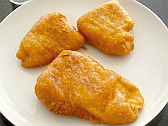

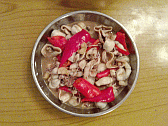
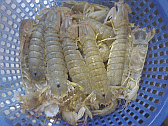
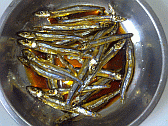
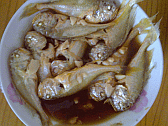
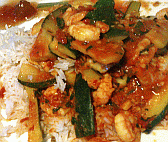
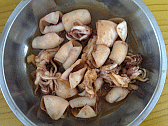
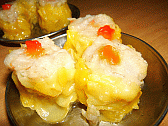
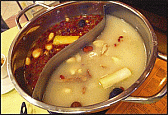
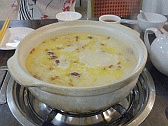
|
|